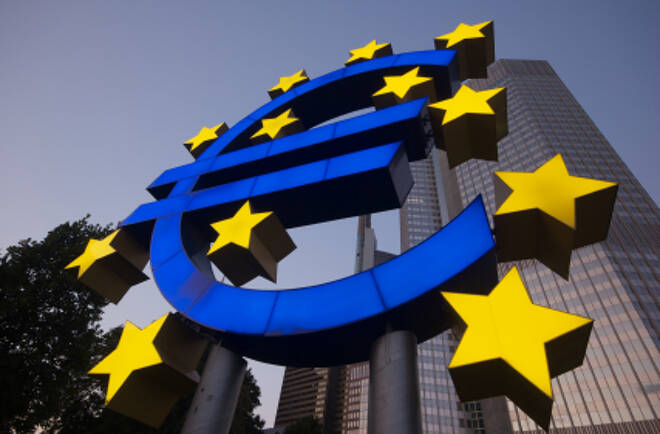Advertisement
Advertisement
EUR/USD Daily Technical Analysis for November 13, 2016
By:
The EUR/USD edged slightly higher on Friday, but continued to trade sideways following a breakdown below support levels in the wake of the dovish
The EUR/USD edged slightly higher on Friday, but continued to trade sideways following a breakdown below support levels in the wake of the dovish guidance from the ECB. French Industrial Production rose, but the guidance from the ECB remains dovish. Sentiment in the U.S. actually contracted despite record high equity prices.
Technicals
The EUR/USD traded sideways, but remains below resistance created from a head and shoulder reversal pattern which is a topping pattern. Support is seen near the 10-day moving average at 1.1631. Resistance is seen near a downward sloping trend line that comes in near 1.1731. Momentum has turned positive as the MACD (moving average convergence divergence) index generated a crossover buy signal. This occur as the MACD line (the 12-day moving average minus the 26-day moving average) crosses above the MACD signal line (the 9-day moving average of the MACD line).
ECB Guidance is Dovish for a Stretch
ECB guidance doesn’t allow rate hike before 2019 according to Nowotny. The Austrian central bank had stressed that the ECB’s guidance to keep rates low until well after the end of asset purchases, means that “realistically speaking, from this perspective, there will only be a change in interest rate policy in the year 2019”. Nowotny also said that he “absolutely” agrees with Weidmann on the need to net asset purchases, saying that officials should center their attention on ending net purchases.
French Industrial Production Rose
French industrial production rose 0.6% month over month, in line with expectations and correcting from a -0.2% month over month drop in the previous month. Manufacturing production rebounded 0.4% month over month, after falling -0.3% month over month in August. Separately, wages growth slowed to 0.3% quarter over quarter from 0.4% quarter over quarter and payroll growth to 0.2% quarter over quarter from 0.4% quarter over quarter. The annual rate bounced back to 3.2% year over year. All in all robust but not stellar performances, but Macron’s reform push may help especially the labour market to recover further going ahead, especially as survey indicators point to swift growth in the manufacturing sector.
Fed’s Bullard said he thinks the current rate is about right. He is concerned the Fed could “send the wrong signal in December by raising the policy rate, and that depresses inflation expectations.” He added, though, that he’s “willing to go with the data, and growth prospects have been better this fall.” Yet he doesn’t expect inflation to be picking up. Meanwhile, data and Fedspeak have the market pricing in a 25 bp tightening next month. He did note that the regulatory environment is very different under the Trump administration, and that’s given business people more confidence. On Powell as Fed chairman, he said the nominee is a “consensus builder,” has “a lot of acumen,” had has a “good future as…chair.” Bullard is not a voter this year, or next.
U.S. Sentiment Contracted
U.S. November consumer sentiment fell 2.9 points to 97.8 in the preliminary print from the University of Michigan survey, giving back about half of the surprise 5.6 point jump to 100.7 in October (that was a 13-year high). The current conditions index slid 2.9 ticks to 113.6 from 116.5 previously. The expectations index also dropped 2.9 points to 87.6 from 90.5. The 12-month inflation gauge sped up to 2.6% from 2.4%. The 5-year index was steady at 2.5%. Though weaker than expected, the readings are coming off of very high levels, and the headline index is still the third best of the year.
UK Trade Deficit narrowed in September
The UK’s trade deficit narrowed in September data, by GBP 700 million, to GBP 2.75 billion. August’s trade gap was also revised lower, to GBP 3.45 billion. The data are better than expected. An increase in exports to Europe, predominantly of cars, offset a drop in exports to non-EU economies. The total trade deficit for Q3 still widened, to GBP 9.5 billion, although the underlying trend, ex erratic goods, is improving as a consequence of improving global growth and the weaker post-Brexit vote pound.
UK September Production Data Beat Expectations
UK September production data beat expectations for the second successive month, with the headline industrial output figure rising 0.7% month over month and by 2.5% year over year. The respective median forecasts had been for 0.2% and 1.8%, and August data were revised upward, to 0.3% month over month and to 1.8% year over year. This is the fourth consecutive month of rising output. The narrower manufacturing production also rose by 0.7% month over month, easily beating the median forecast for 0.3% expansion. Production rose by 1.1% quarter over quarter in Q3, driven by strong production levels of cars and medical equipment.
About the Author
David Beckerauthor
David Becker focuses his attention on various consulting and portfolio management activities at Fortuity LLC, where he currently provides oversight for a multimillion-dollar portfolio consisting of commodities, debt, equities, real estate, and more.
Did you find this article useful?
Latest news and analysis
Advertisement
